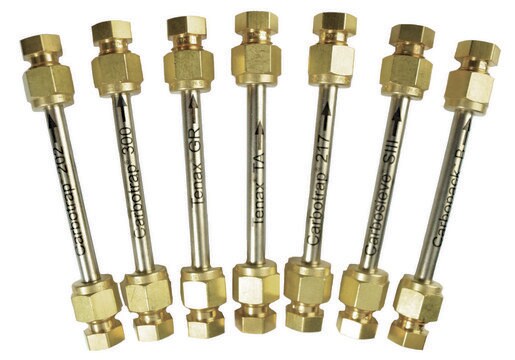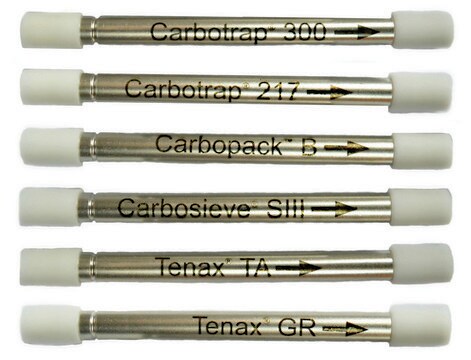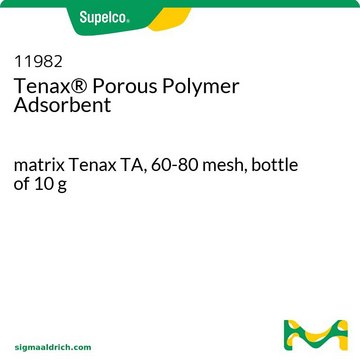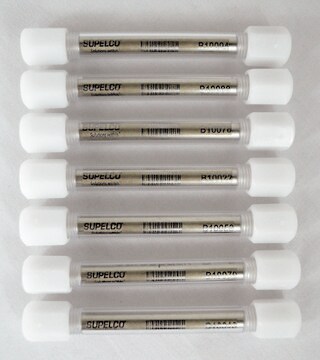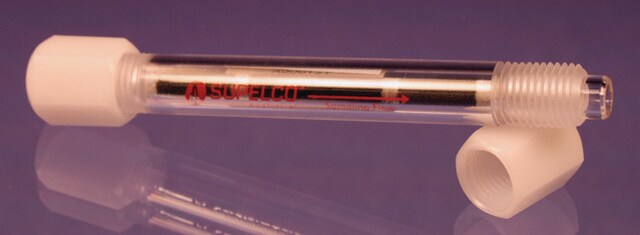Kluczowe dokumenty
20010-U
Tenax® TA Thermal Desorption Tube
stainless steel, O.D. x I.D. x L 1/4 in. × 3 1/2 in., preconditioned, pkg of 10 ea
Synonim(y):
Rura do desorpcji termicznej Tenax TA (stal nierdzewna)
About This Item
Polecane produkty
Nazwa produktu
Tenax® TA, stainless steel TD tube, O.D. × L 1/4 in. × 3 1/2 in., preconditioned, 60-80 mesh, pkg of 10 ea
Materiały
stainless steel TD tube
Poziom jakości
agency
EPA TO-1,IP-1B
opis
Sealed with TDS³ Storage Container
Właściwości
preconditioned
opakowanie
pkg of 10 ea
charakterystyka ekologicznej alternatywy
Waste Prevention
Safer Solvents and Auxiliaries
Learn more about the Principles of Green Chemistry.
sustainability
Greener Alternative Product
metody
active air sampling: suitable
śr. zewn. × dł.
1/4 in. × 3 1/2 in.
Matryca
Tenax TA porous polymer
wielkość cząstki
60-80 mesh
Zastosowanie
air monitoring
environmental
industrial hygiene
kompatybilność
for use with PerkinElmer, Markes, DANI, OI Analytical, and Shimadzu Instruments
kategoria ekologicznej alternatywy
Szukasz podobnych produktów? Odwiedź Przewodnik dotyczący porównywania produktów
Opis ogólny
Zastosowanie
- Wyznaczanie wskaźników emisji ze składowiska odpadów za pomocą metodologii odwrotnej: Eksperymentalne określenie stężeń w otaczającym powietrzu i wykorzystanie modelowania numerycznego...: Niniejsze badanie koncentruje się na identyfikacji wskaźników emisji ze składowisk odpadów przy użyciu kombinacji eksperymentalnego gromadzenia danych dotyczących otaczającego powietrza i modelowania numerycznego w celu lepszego zrozumienia wpływu na środowisko (Gallego et al., 2024 Apr 28) (Gallego et al., 2024).
- Analiza lotnych związków organicznych w koreańskich truskawkach: wgląd w poprawę smaku owoców..: Badania te analizują profile lotnych związków organicznych w truskawkach w celu poprawy ich smaku, zapewniając wgląd cenny dla sektorów rolnictwa i chemii spożywczej (Jee i in., 2024) (Jee i in., 2024).
- Dostępność biologiczna halogenowanych środków zmniejszających palność i estrów fosforoorganicznych w pyle osiadłym: Wpływ określonych matryc pyłu z nieformalnych obszarów przetwarzania e-odpadów i pojazdów wycofanych z eksploatacji w Wietnamie...: Badanie to ocenia biodostępność różnych środków zmniejszających palność w próbkach pyłu z obszarów recyklingu e-odpadów, przyczyniając się do wiedzy na temat zdrowia i bezpieczeństwa środowiska (Hoang et al., 2024 May 20) (Hoang et al., 2024).
- Wpływ rozpylania odświeżacza powietrza na cząstki stałe i lotne związki organiczne w pojazdach..: Badając wpływ odświeżaczy powietrza na jakość powietrza wewnątrz pojazdów, badanie to zapewnia wgląd w zmiany stężeń cząstek stałych i lotnych związków organicznych, istotnych dla zdrowia środowiskowego (Lee i in., 2024 Mar 15) (Lee i in., 2024).
- Kompaktowy monitor etylenu i innych lotnych związków organicznych wytwarzanych przez rośliny dla misji kosmicznych NASA...: W artykule opisano rozwój kompaktowego systemu monitorowania etylenu i innych lotnych związków organicznych w środowisku kosmicznym, podkreślając jego zastosowania w biologii kosmicznej i naukach fizycznych (Dobrokhotov et al., 2023 Dec 8) (Dobrokhotov et al., 2023).
Informacje prawne
Hasło ostrzegawcze
Warning
Zwroty wskazujące rodzaj zagrożenia
Zwroty wskazujące środki ostrożności
Klasyfikacja zagrożeń
Eye Irrit. 2 - Skin Irrit. 2 - STOT SE 3
Organy docelowe
Respiratory system
Kod klasy składowania
11 - Combustible Solids
Klasa zagrożenia wodnego (WGK)
WGK 3
Temperatura zapłonu (°F)
Not applicable
Temperatura zapłonu (°C)
Not applicable
Wybierz jedną z najnowszych wersji:
Certyfikaty analizy (CoA)
It looks like we've run into a problem, but you can still download Certificates of Analysis from our Dokumenty section.
Proszę o kontakt, jeśli potrzebna jest pomoc Obsługa Klienta
Masz już ten produkt?
Dokumenty związane z niedawno zakupionymi produktami zostały zamieszczone w Bibliotece dokumentów.
Klienci oglądali również te produkty
Nasz zespół naukowców ma doświadczenie we wszystkich obszarach badań, w tym w naukach przyrodniczych, materiałoznawstwie, syntezie chemicznej, chromatografii, analityce i wielu innych dziedzinach.
Skontaktuj się z zespołem ds. pomocy technicznej